Reducing Pain and Stiffness While You Work
The year 2020 brought many changes to our lives. For example, many people have had to adapt to working from home. In some cases, they have set up home offices that are less than ideal.
When your workspace is not set up ergonomically, you may experience increased stress and strain on your joints and muscles – and poor posture just makes it worse. Let’s look at some common signs and symptoms that can result from poor posture. Then, let’s consider some preventative measures that will keep your muscles and joints happy!
What is Posture?
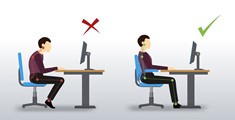
Posture is “…the position of the limbs or the carriage of the body, as a whole.”[1] You should aim to have correct or neutral posture, which places minimal stress on your muscles, tissues, joints and ligaments.[2] When you sit using poor posture, you may experience a number of negative effects. Over time, these can lead to chronic pain if they are not corrected. Please see the image to the left (from Google images):
What are the negative effects of poor posture?
1) Muscular imbalance
Muscular imbalance often appears as a combination of tight, weak muscles, with opposing muscle groups on the front and back of the body. This can be found in both the upper and lower parts of the body. Please see the image below (from Google images, or https://nwcalgarychiro.ca/upper-cross-syndrome/ and https://www.yoganatomy.com/lower-crossed-syndrome/).
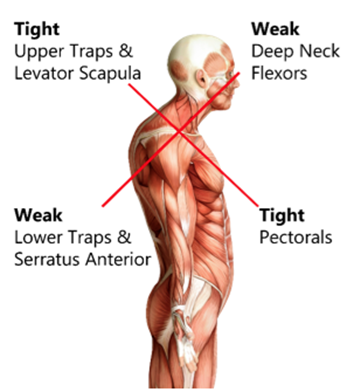
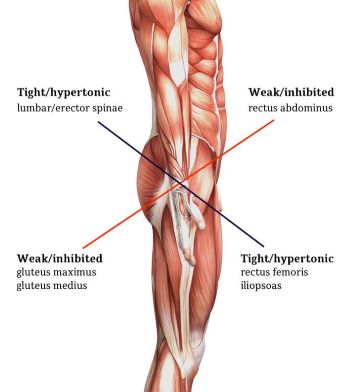
2) Decreased respiratory function
Sit with your head in a forward position and your shoulders rounded. Notice that as you breathe, your chest cannot expand easily. To breathe properly, you must be able to expand your chest. Over time, this kind of poor posture inhibits the capacity of your ribs to expand. The pressure in your abdominal area will increase, making it difficult for your diaphragm – the major muscle of breathing – to contract and allow air to fill your lungs.(3)
3) Increased joint wear and tear
When you have poor posture, the curvature of your spine often becomes more pronounced. This increases the stress on your joints. Over time, this results in increased wear on your joints because your poor posture put more pressure on them. This increases your chance of developing osteoarthritis. Please see the image below (from Google images or https://mypilates.co.za/poor-posture-spine/).
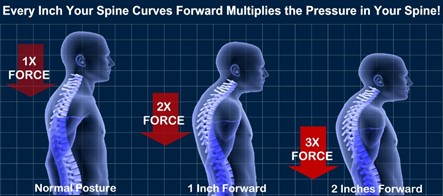
4) Decreased circulation
When you are sitting, there is less demand on your circulatory system because you aren’t actively moving. This results in a lower heart rate and less blood flow to the muscles. Sitting may seem like a passive activity, but your muscles have to work hard to maintain a fixed position. Insufficient blood flow causes muscles to grow tired more quickly, which makes them more prone to injury.[4]
How to Prevent the Effects of Poor Posture
1) Proper workstation
Setting up your workspace to ensure proper ergonomics is important. Whether you are working from home or in the office, using proper posture while you work helps to reduce the strain on your body. Please see the following link for tips on how to create and use an ergonomic workspace: (5)
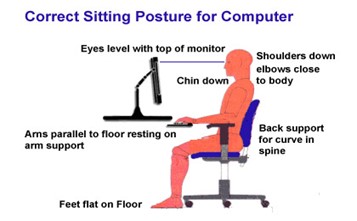
2) Take breaks
The Canadian Centre for Occupational Health and Safety recommends that you take a five- to 10-minute break for every hour you’re seated while you work. Standing up and walking around is an ideal break-time activity. Please see the following link for additional resources: https://www.ccohs.ca/oshanswers/ergonomics/office/stretching.html.
3) Stretching
While you’re at your workstation, you can do a series of stretches throughout the day to minimize muscle strain. Make sure to hold your stretches for a minimum of 30 seconds. Avoid stretching to the point where you feel any pain or discomfort! Keeping these thoughts in mind, here are a few ideas to get you started:
-
Upper fibre trapezius muscle
The trapezius is a large, paired muscle extending from the base of your skull, down your back to the lower chest area of the spine and to the shoulder blade (scapula). The upper fibres of the trapezius muscle support the weight of the arm.
On the side of the trapezius muscle that you want to stretch, grasp the bottom of your chair with your hand. Then side-bend your head away. You should feel a stretch along the side of your neck. Repeat this stretch on the other side.
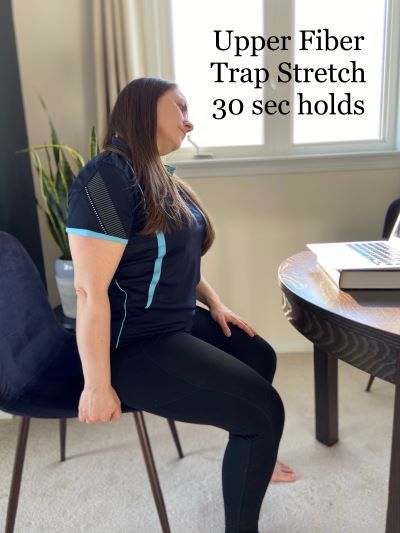
-
Thoracic-spine extension
The thoracic spine area of your spinal column begins at the base of your neck and continues down to upper section of your lower back.
To stretch your thoracic spine area, sit with your hips and back against the back of your chair. Clasp your hands behind your head, pulling your elbows in toward your midline. Arch your back over the top of the back of the chair, pointing your elbows toward the ceiling. Be careful not to overextend through your lower back. Repeat this stretch 10 times, slowly and in a controlled manner.
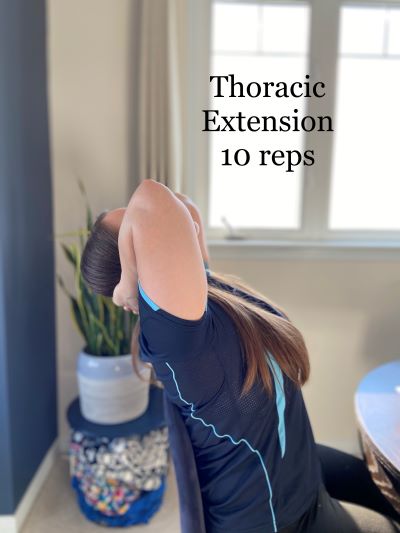
-
Pectoralis muscles
Located on the front of your chest wall, the four pectoralis muscles help to move your arms.
To stretch your pectoralis muscles, hold onto the edge of your desk or table with one hand. Turn your body away from where you are holding until you feel a gentle stretch along the front of your chest and arm. Then change hands and do the exercise again, on the other side.

-
Quadratus lumborum
The quadratus lumborum is the deepest abdominal muscle, located in your lower back, on either side your spine.
To stretch the quadratus lumborum muscle, sit tall in your chair. Reach one arm up above your head. Then side-bend away until you feel a gentle stretch along the side of your torso. Then change arms and do the exercise again, on the other side.
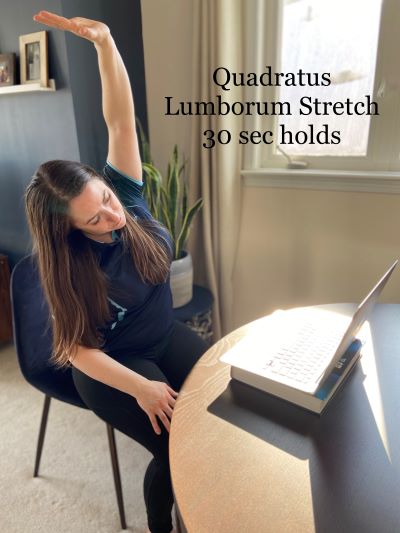
-
Gluteal muscles
The three gluteal muscles are located in your buttocks, between back of your pelvis and the top of your thigh. The gluteal muscles move your leg at your hip joint.
To stretch the gluteal muscles, sit toward the edge of your chair. Cross one leg over the other. Keeping a tall posture, lean forward until you feel a gentle stretch through your gluteal muscles.
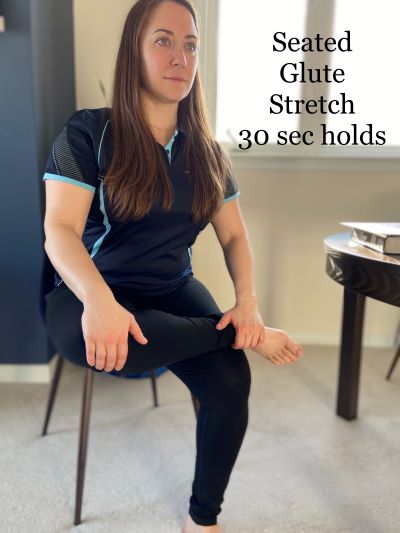
4) Strengthening
If you do a few simple exercises while you work, you can improve circulation. Sitting can compress your circulation in some areas. You can also as strengthen the smaller postural muscles that help you maintain proper posture.
-
Scapula (shoulder blade) sets
Start by sitting tall in your chair. Draw your shoulder blades together toward the midline of your back, then draw them down, each toward your opposite back pocket. Be careful to avoid tension in your upper trapezius/neck muscles. Hold this position for 10 seconds, then release and repeat. You can do this exercise periodically throughout the day, whenever you think of it.
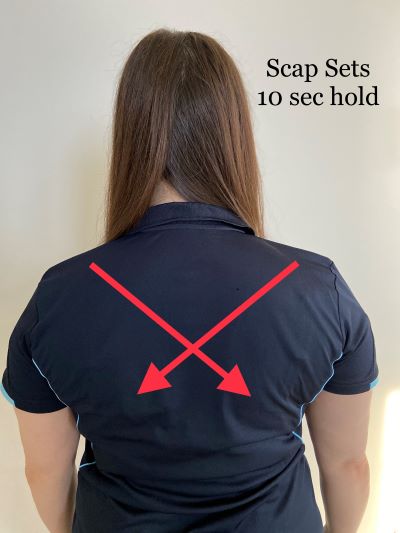
-
Chin tucks
Sit tall in your chair, with your shoulders pulled back into a scapula-set position (as described above). Avoid flexing your neck forward and down, and pull your chin toward the back of your throat, creating a double chin. As you do this, avoid contracting too much. Hold for five seconds, release and repeat. You can perform this exercise periodically throughout the day, whenever you think of it.
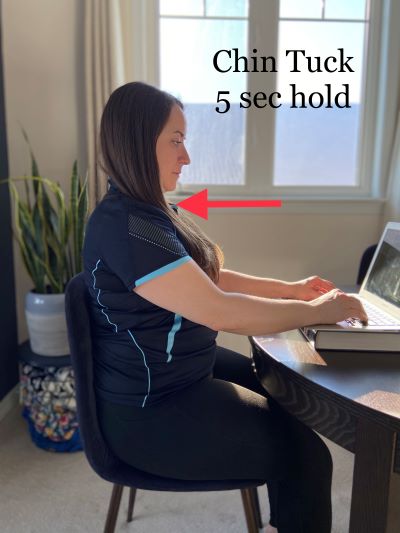
-
Seated calf raises
While sitting at your desk, lift your heels off the floor. As you do this, you will feel your muscles tighten in your lower leg. Lower your heels back to the floor and repeat. You can do this exercise easily while you work, without being distracted. It helps with circulation.
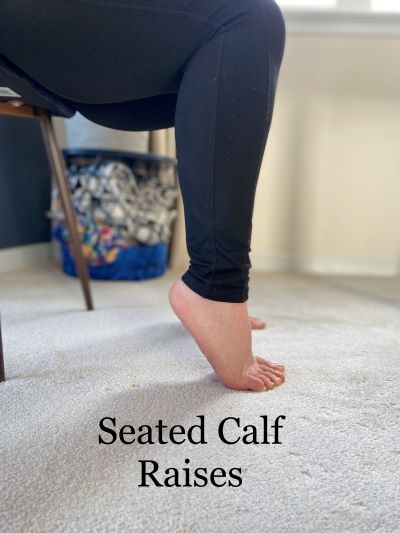
-
Seated knee extensions
While sitting with the chair supporting your back, slowly extend one leg, with your ankle flexed and your toes pulled up. As you do this, extend the knee as straight as you can. Hold for five seconds, then lower your foot to the floor. Then repeat this exercise, using the opposite leg. You can do this exercise easily while you work, without it causing a distraction. This exercise helps with circulation.
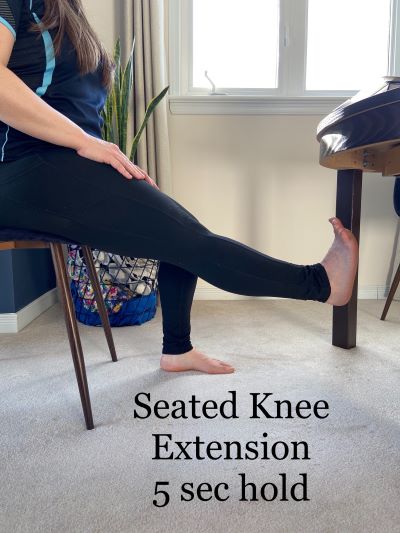
FAQ’s
Can I change my poor posture?
Yes! You can change your poor posture in several ways: by developing greater body awareness;
- by learning more about correct posture; and
- by engaging in a strengthening-and-stretching program that focuses on your personal strengths and weaknesses.
Do I have to keep my back straight the entire time I am working?
No. Trying to maintain perfect posture all day is exhausting! You can set reminders on your phone or computer, to prompt you to do a few exercises and stretches each hour. Over time and with practice, you will automatically sit a bit taller without consciously thinking about it.
How do I know if I have good or bad posture?
It can be challenging to do a self-assessment on your own. But you can watch for a couple of signs and symptoms of poor posture. For example:
- When you’re sitting, does your head jut forward past your shoulders?
- After sitting or standing for a long time, do you often feel low-back pain?
- Do you have frequent headaches? Do you feel tension in your neck?
These are just a few of the common signs and symptoms of poor posture. By making an appointment with a health-care practitioner, you can learn whether you have good or bad posture – and if you have poor posture, you can learn how to correct it!
REFERENCES:
[1] https://www.dictionary.com/browse/posture (accessed March 5, 2021).
[2] Erin M. Friend, “Poor Posture and its Effects on the Body,” National Spine Health Foundation website, found at https://spinehealth.org/poor-posture-and-its-effects-on-the-body/ (accessed March 5 2021).
[3] Hamayun Zafar, Ali Abarrati, Ahmad H. Alghadir, Zaheen A. Iqbal, “Effect of Different Head-Neck Postures on the Respiratory Function in Healthy Males,” Biomed Research International, published online July 12, 2018, found at https://www.ncbi.nlm.nih.gov/pmc/articles/PMC6077663/ (accessed March 5, 2021).
[4] Canadian Centre for Occupational Health and Safety website, “Working in a Sitting Position – Overview: OSH Answers Fact Sheets,: found at https://www.ccohs.ca/oshanswers/ergonomics/sitting/sitting_overview.html (accessed March 5, 2021).
Author:
Kristen Sarlo
Registered Kinesiologist
Athletic Therapist